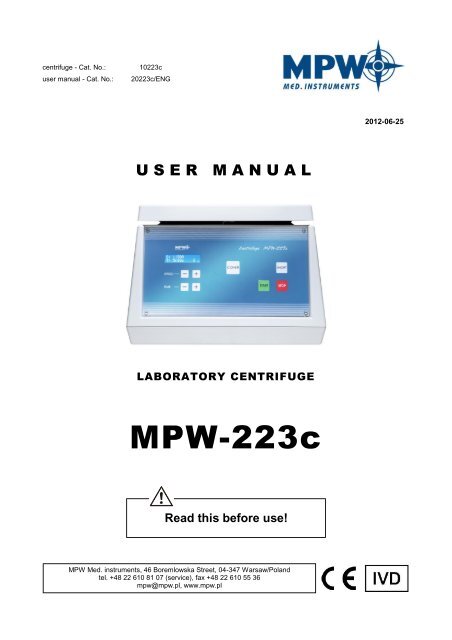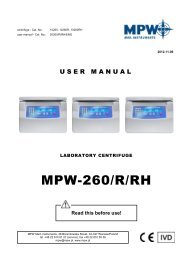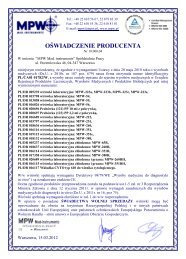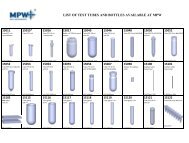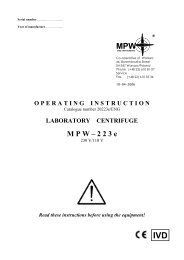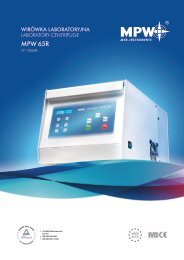download - MPW MED. INSTRUMENTS SpóÅdzielnia Pracy
download - MPW MED. INSTRUMENTS SpóÅdzielnia Pracy
download - MPW MED. INSTRUMENTS SpóÅdzielnia Pracy
Create successful ePaper yourself
Turn your PDF publications into a flip-book with our unique Google optimized e-Paper software.
centrifuge - Cat. No.:user manual - Cat. No.:10223c20223c/ENG2012-06-25U S E R M A N U A LLABORATORY CENTRIFUGE<strong>MPW</strong>-223cRead this before use!<strong>MPW</strong> Med. instruments, 46 Boremlowska Street, 04-347 Warsaw/Polandtel. +48 22 610 81 07 (service), fax +48 22 610 55 36mpw@mpw.pl, www.mpw.pl
Warning sings and hazard icons.WARNINGWarning of potential injury or health risk.DANGERRisk of electric shock with potential for severe injury or death as a consequence.DANGERBiohazard with potential for risk to health or death as a consequence.DANGERRisk of explosion with potential for severe injury or death as a consequence.Statement of Conformity:The following machine is in accordance with the regulations of the EU Directive 98/79/EC and with theharmonized standards PN-EN 61010-1 and PN-EN 61010-2-020.2
Contents1. Application.2. Technical data.2.1. Accessories.2.1.1. Basic accessories.2.1.2. Special accessories - „Cytoset”2.1.3 Optional accessories2.2. Exploitation materials.3. Installation.3.1. Unpacking of the centrifuge.3.2. Location.3.3. Connection to mains.3.4. Fuses.4. Description of the centrifuge.4.1. General description.5. Safe working conditions.5.1. Operating personnel.5.2. Guarantee period and operation life.5.3. Storage period.5.4. Hints on centrifuging.5.5. Hazards and precautions.6. Operation of the centrifuge.6.1. Mounting of the rotor and accessories.6.2. Construction and safety measures.6.3. Drive.6.4. Data input and output.6.5. Controls.6.6. Safety devices.6.6.1. Cover lock.6.6.2. Rest state check.7. Description of the centrifuge operating elements.7.1. Control panel7.2. Switching the centrifuge on7.2.1. Selection of the program.7.2.2. Start of the program.7.2.3. Emergency stop.7.2.4. End of the centrifuging.7.2.5. Programming.7.3. Mathematical relations.7.3.1. RCF – relative centrifugal force, nomograph.3
8. Cytology kit cytoset.8.1. Intended Use.8.2. Benefits of "Cytoset".8.3. Work parameters.8.4. Kit contents.8.5 Working principle.8.6. Preparation of samples for centrifugation.8.7. Table of dilutions in hematology8.8. Preparation of the cyto-container with the passing of the filtrate through blotting paper.8.9. Preparation of the cyto-container with filtate retrieval8.10. Centrifugation parameters8.11. Steps in the use of centrifuge with the "CYTOSET" kit8.12 Procedure after centrtifugation, when the filtrate is lost8.13. Procedure following centrifugation, with the filtrate retrieved8.14. General View of Cytology kit – Cytoset.9. Cleaning, disinfection, maintenance.9.1. Cleaning of the centrifuge.9.2. Cleaning of the accessories.9.3. Sterilization and disinfection of the rotating chamber and accessories.10. Emergency conditions – service.10.1. Troubleshooting.11. Work safety.11.1. Work safety inspection procedures.11.2. Inspection procedures carried out by the operator.12.Conditions of repairs.13. Manufacturer’s data.14. Information about Distributor.15. Table of chemical resistance to the interaction of various categories of reagents of plasticsAnnexes:• Statement of conformity• Declaration of decontamination (repair)• Declaration of decontamination (return)4
3.4. Fuses.The centrifuge has standard protection with the WTA-T 4A 250 V fuse situated in the plug-in socket andmaster switch unit at back wall of the centrifuge.4. Description of the centrifuge.4.1. General description.New generation of <strong>MPW</strong> Med. instruments laboratory centrifuges is provided with modern microprocessorcontrol systems, very durable and quiet asynchronous brushless motors and accessories consistent withmodern requirements.4.2 Maintenance elements.12341. Cover2. Emergency cover release3. Control panel4. Clamping bolt5. Rotor6. Motor shaft567
5. Safe working conditions.5.1. Operating personnel.<strong>MPW</strong>-223c laboratory centrifuge can be operated by laboratory personnel after getting acquainted with theOperating Instruction.Operating Instruction shall be held all the time near the centrifuge.Operating Instruction must be kept close always at hand!!!5.2. Guarantee period and operation life.Guarantee period for <strong>MPW</strong>-223c centrifuge amounts to minimum 24 months.Principles are specified in guarantee certificate. The service life of the centrifuge specified by themanufacturer amounts to 10 years.After termination of guarantee period it is necessary to carry out yearly technicalinspections of the centrifuge. Only service personnel authorized by manufacturer mayperform the inspections.The manufacturer reserves the right to make modifications at produced goods.5.3. Storage period.Maximum period of storage of not used centrifuge amounts to 1 year. After this period one should askauthorized service to carry out an inspection of the device.5.4. Hints on centrifuging. Set the centrifuge in horizontal position on rigid base. Ensure safe positioning location. Ensure free space around the centrifuge (amounting to at least 30 cm left free). Ensure sufficient ventilation. Fix the rotor on the motor axis firmly.Avoid unbalance.Load opposite buckets with the same accessories.Centrifugation of the test tubes of different sizes.There is a possibility to centrifuge test tubes of different sizes; however, it isabsolutely necessary in such cases that opposite buckets and round carriers be thesame. Mass of different containers with test tubes spun at the same time has to becomparable.Not only the test tubes shall be inserted symmetrically, but also round carriers andtheir hangers shall be equally loaded. It is e.g. not allowed to operate centrifuge onlyexternal part of reductive insert loaded.It is necessary to insert test tubes symmetrically on the opposite sides.Fill test tubes outside the centrifuge.Please pay special attention to the quality and proper thickness of the glass test tubeswalls. Those shall be test tubes for centrifuges, of proper durability up to 5,000 x g.8
In order to protect the centrifuge against unbalance, fill in the test tubes up to thesame weight.Lubricate the swing-out rotor journal pins.Use only accessories in good condition.Protect equipment against corrosion using accurate preventive maintenance.Infectious materials could be processed in closed buckets only.It is not allowed to centrifuge explosive and inflammable materials.It is not allowed to centrifuge substances prone to reacting in result of supplying highenergy during centrifugation.5.5. Hazards and precautions.Prior to switching the centrifuge on, one shall read carefully all sections of thisinstruction in order to ensure smooth operation and avoid damages of this device orits accessories.Centrifuge shall not be operated by unqualified personnel.Centrifuge must not be transported with the rotor mounted on the shaft.One must use original rotors, test-tubes and spare parts only.In the case of faulty operation of the centrifuge one shall ask for assistance of serviceof <strong>MPW</strong> Med. instruments Company or its authorized representatives.It is not allowed to switch the centrifuge on if it is not installed properly or rotor isnot fitted correctly.The centrifuge must not be operated in places where explosion hazard exists as it isnot explosion-proof.It is not allowed to centrifuge materials capable of generating inflammable orexplosive mixtures when subjected to air.It is not allowed to subject to centrifugation toxic or infectious materials withdamaged leak proof seals of the rotor or test-tube. Proper disinfection procedureshave to be carried out when dangerous substances contaminated the centrifuge or itsaccessories.It isn't allowed to open the cover manually in emergency procedure when rotor is stillturning.It isn't allowed to exceed load limit set by the manufacturer. Rotors are intended forfluids of average homogeneous density equal to 1.2 g/cm 3 or smaller whencentrifugation is carried out at maximum speed. When fluids of higher density shallbe used, then it is necessary to limit speed (see point 7.3.3 “Maximum load”).It is not allowed to use the rotors and round carriers with signs of corrosion or othermechanical defects.It is not allowed to centrifuge highly corrosive substances which may cause materialimpairment and lower mechanical properties of rotor and round carriers.9
It isn’t allowed to use rotors and accessories not admitted by the manufacturer. Let touse commercial glass and plastic test tubes, which are destined to centrifuging in thislaboratory centrifuge. One should absolutely not use poor quality elements. Crackingof glass vessels and test tubes could result in dangerous vibration of the centrifuge.It is not allowed to carry out centrifugation with the rotor caps taken off or notdriven tight.It is not allowed to lift or shift the centrifuge during operation, and rest on it.It is nor allowed to stay in the safety zone within 30 cm distance around the centrifugeneither leave within this zone some things, e.g. glass vessels.It is not allowed to put any objects on the centrifuge.6. Operation of the centrifuge.6.1. Mounting of the rotor and accessories.1. Connect the centrifuge to mains (master switch at back wall of the centrifuge).2. Open the cover of the centrifuge pushing the pushbutton COVER. Prior to putting the rotor inone has to check if rotating chamber is free of impurities, e.g. such as dust, glass splinters,residues of fluids that must be taken away.3. One shall release with special spanner clamp on the motor shaft and fit the rotor on the motorshaft driving it home on the cone.4. Screw-in the bolt for fixing the rotor (clockwise) and screw it tightly home with the suppliedspanner.5. Put the Cyto-container hangers into rotor.6. Fill test Cyto-container outside the centrifuge, just before centrifuging.7. For replacement of the rotor one shall release clamping by several turns of the bolt and thenusing both hands grab the rotor at opposite sides taking it away from drive shaft by pulling it up.Earlier take the hangers out of the rotor.6.2. Construction and safety measures.The centrifuge has rigid self-supporting structure. Housing is made of plastic while front is made of steelsheet. Cover is fixed on steel axles of hinges and from the front is locked with electromagnetic lock blockingpossible opening during centrifugation. Bowl forming the rotation chamber is made of acid resistant steelsheet.6.3. Drive.Drive constitutes brushless induction motor of low noise level, free of carbon brushes. This solutioneliminated the danger of contamination the preparations with carbon dust.6.4. Data input and output.Data setting and read-out system forms hermetically closed keyboard with distinctly accessible operationpoints. Easily readable display signalling individual performed operations facilitates to operatorprogramming of condition of the centrifuge.Operation of the centrifuge is simple and self-evident.6.5. Controls.Microprocessor control system being used in the centrifuge ensures the following possibilities of setting ofparameters of operation:- stepwise rotational speed selection within the range from 300 up to 2500 rpm every 100 rpm,- setting of the centrifugation time within the range from 1 up to 99 minutes,- selection of “SHORT” short duration operation setting for pre-programmed speed.10
6.6. Safety devices.Apart from the above described passive devices and safety measures there exist as well active devices andelements as follows:6.6.1. Cover lock.The centrifuge can be started only with properly closed cover. The cover can be opened only after stoppingthe rotor. In the case of emergency opening of the cover during operation the centrifuge will be immediatelyswitched-off and the rotor will be braked until stopping completely. With opened cover, the drive iscompletely disconnected from power which makes it impossible to start the centrifuge.Emergency cover releaseIn the possible case of failure, such e.g. as power failure there exists possibility of manual opening of thecover. On the right side of the housing there is a small opening in which one shall put 2mm bar or key andpush it, and the cover will be opened by itself.CAUTION! Cover can be released and opened only when rotor is in the rest state.6.6.2. Rest state check.Opening of the centrifuge cover is possible only with the rotor in the state of rest. This state is beingchecked by the microprocessor which recognizes and signals the rest state prior to opening the cover withletter S (Stop).7. Description of the centrifuge operating elements.Power switching ON/OFF is carried out with master switch situated on back of the centrifuge. All settingson the centrifuge are done by means of the control panel. Panel comprises control pushbuttons, displays andsignalling LEDS.7.1. Control panel.Control panel placed on front casing wall serves for controlling centrifuge operation. Control panelcomprises the following elements:,Control panel1. Upper display field S: 4 digits (rpm) RCF 4 digits (x g)2. Lower display field T: 4 digits (min/sec) S (STOP), O (opened cover), U (unbalance)3. Error signalling4. Rotor status signalling STATUS COVER blinking - rotor rotates,lack of blinking - rotor does not rotate.11
5. Functional key6. Functional key7. Functional key► Buzzer serves for signalling function recording and determination of the centrifuge status.►►►►►►key serves for starting centrifugation program with parameters presented on display,key serves for:- interrupting centrifugation program in any program phase and braking the rotor,- saving of preset SPEED and TIME centrifugation parameters,key serves for opening of the cover,serve for speed programming,serve for time programming,key serves for short duration operation.7.2. Switching the centrifuge on.After switching power ON the control system calls recently implemented program and displays in relevantfields rotational speed, duration of centrifugation and cover opening status. Provided that rotor in thecentrifuge is stopped, it is possible to open the cover by means of COVER key.Stopped rotor status isdisplayed as a S letter symbol in the display field. When this symbol is not already displayed, then one mustwait till this rotor stops and the above mentioned symbol appears.7.2.1. Selection of the program.Control panel can save 1 program preset by the user. Program acceptance consists in pushing STOP key.7.2.2. Start of the program.After acceptance of the program and checking if rotor was mounted, centrifuge can be started with pushingSTART key, provided that cover is closed.7.2.3. Emergency stop.At any time during centrifuging it is possible to interrupt the process and stop the rotor quickly with singlepushing of STOP key.7.2.4. End of the centrifuging.After termination of time of centrifugation preset in the program, braking follows. At the end of decelerationthe rotational speed drops at slower rate in order to ensure soft settling of Cyto-container. Stopping isfollowed by buzzer signal and is displayed by S letter symbol. After pushing COVER pushbutton the coveropens and O symbol is displayed.7.2.5. Programming.Programming mode is activated with pushing SPEED and TIME (+) (-) keys after selection of parameters ofthe program which one would like to save or change. Acceptance of preset parameters is done by pushingSTOP key. One can save one program only.12
7.3. Mathematical relations.7.3.1. RCF - relative centrifugal force.RCF acceleration is the acceleration generated by the rotor rotary motion acting upon tested product and itcan be calculated according to the formula:RCF = 11.18 * r * (n/1000) 2where RCF [x g]; r [cm]; n [rpm]Depending on the distance of particles of the tested product from the axis of rotation one can find fromabove formula minimum RCF, average RCF or maximum RCF. On the basis of preset RCF value and givenradius of the bottom in the test-tubes one can calculate from the formula the rotational speed to be set in theprogram of centrifuging. Selection of the time of sedimentation and the RCF value shall be carried outexperimentally for a given product.Once every 100 rpm electronic circuit NOMOGRAM automatically calculates and displays averaged RCF value.ACentrifuging radius [cm]5045403530292827262524232221201918171615141312111098765Formula used for calculation of thisnomogram :2R.C.F.= 11,18 * r * (n/1000)where :R.C.F. - multiple ofgravitational speedr - centrifuging radius (cm)n - rotational speed (r.p.m.)g - gravitational accelerationExample of making useA=14,4 cmB=4600 r.p.m.C=3400 x gn 1000 *rof the nomogram:11,18RCF* RCF11,18 * rn10002 R.C.F. (x "g")multiple ofgravitationalacceleration100000500004000030000200001500010000800060005000400030002400200015001200100080060050040030020015012010080605040302520151086543CB[r.p.m]2000015000140001300012000110001000090008000700060005000450040003500300025002000150014001300120011001000900800700600500400300200Nomograph13
8. Cytology kit – Cytoset.8.1. Intended Use.The kit for cytological purposes “Cytoset” is standard equipment for the <strong>MPW</strong>-223c centrifugemanufactured by <strong>MPW</strong> Med. instruments. Its intended use is the centrifugal separation of body fluids intofine subconstituent elements from the filtrate. The fine elements are deposited directly on basic microscopeslides, while the filtrate is accumulated in special 2.2 ml tubes, following the settling of the particulatematter. The tested physiological fluids constitute a suspension of fine elements in the fluid fraction.Among them are the following:a) natural biological fluids including: cerebrospinal fluid, urines, effusions, serum leaks, joint fluid,leukorrhoea, pus and related others,b) suspensions in isotonic smear solutions, tissue punctuates, sputum, rinsings form the bronchi andrespiratory pathways and related others.These suspensions may be tested in order to:1) obtain precipitates of fine matter and the filtrate from the same sample of tested biologicalsuspension,2) obtain just a precipitate of the fine matter through passing of the filtrate into a blotting paperThe cytology kit is essential in medicine and veterinary science, and may also be used in industry as well astechnology.8.2. Benefits of “Cytoset”Fast desposition of cells on the microscope slide through centrifugation and the penetration of thefiltrate into the blotting/filter paper.Possibility of filtrate recovery after the cells have settled on the slide by its automatic collection into atest tube.Securing the fluid against its escaping into the centrifugation chamber (avoiding air-borncontamination).Inserts used as disposable equipment will help prevent infections, contamination of lab personnel or theenvironment.Possibility of having varied size (diameter) areas of cell settlement on the microscope slide.8.3. Work parameters.Rotational speedMax. accelerationMax. centrifugation volumeArea diameter of settling cells on the microscope slide500 - 2500 rpm750 x g2 ml 8.7 mm.14
8.4. Cytoset contents.The kit contains a horizontal four-pocket rotor with hangers, into which the complete cyto-container isplaced.68745321Drawing No. 1.Cyto-container.The complete insert contains the following:- base – collection chamber (1),- basic microscope slide (2),- blotting/filter card (3),- cyto-container (4),- seal 8.7 mm (60 mm 2 ),- plug (6),- plug (7),- dacantation test tube (8).8.5. Working principle.During the centrifugation, the cyto container change into a horizontal position, which positioning is thenblocked with snap fastening units located in the side arms of the rotor in case of the need to decant thefiltrate.Under the centrifugal force the morphotic elements (cell precipitate) are separated from thesuspension and settle on the microscope slide. The cell-free filtrate, depending on the method used, is eitherabsorbed by the blotting paper or decanted into a test tube following centrifugation. After the decantationtest tube containing the filtrate is removed in order to dry the precipitate on the microscope slide, the testtube is subjected to a second centrifugation.15
Cell precipitateCYTOFiltrateSUPERNATANTDrawing No. 2.The cyto-container, following the completion of the settling of the morphotic elements on the basic slidecentrifugation with filtrate retrieval.8.6. Preparation of samples for centrifugation.The amount of fluid used in centrifugation depends on its contents of cells, as well as its availability. If thefluid is cell-dense in order to avoid layering of the cells on the slide or their settling too densely, the fluidshould be diluted with 0.9 % NaCl solution or PBS.8.7. Tabel of dilutions in hematology.Number ofwhite cells101 - 300301 - 700701 - 15001501 - 3000Dilutionfactor-1 : 21 : 51 : 10Sampledrops201042Saline drops0101618When a cell-poor fluid with a low protein content (about 0.2 mg/ml) is tested there exists a danger, that thecentrifuged cells on the slide may be fragmented, as well as the quality of the preparation is often notsatisfactory. For that reason, if the filtrate is not needed for further tests, it is recommended that a few dropsof blood serum or albumin solutions be added. Samples destined for cyto-centrifugation should be fresh inorder to maximize the possibility of getting intact cells.16
8.8. Preparation of the cyto-container with the passing of the filtrate through blotting paper (with aloss of the filtrate).- Prepared and labeled basic microscope slide should be inserted into the base-collector. In order to obtainbetter cell adhesion to the slide it is recommended that the slides be covered with poly-L-lysine,manufactured by “Sigma” – Chemical.- Place the blotting paper, with a suitable opening depending on the seal used, on the slide. Usefiltration/blotting card with an opening of 9.5.- Place the plugs on the cyto insert.- Place the complete cyto insert onto the base-collector and symetrically close the snap-fastening catch.- Pour the prepared fluid sample into the central cylinder of the cyto-container and close with a plug.The maximum amount of fluid, which the cyto insert can hold is 2 ml.That volume is marked with a line.Drawing No. 3.8.9. Preparation of the cyto-container with filtate retrieval.- Prepared and labeled basic microscope slide should be inserted into the base-collector.- Place the blotting/filter card with an opening of 12.5 over the slide.- Place the plug and the decantation tube over the cyto-container.- Place the complete cyto-container over the base-collector and symetrically close the snap-fasteningcatch.- Pour in the tested biological fluid, suspension into the central cylinder of the cyto-container and closewith a plug (max. 2 ml).DIAMETER OF OPENINGS IN FILTRATION PAPERSealCentrifugation 8.7With a loss of the filtrate into thefiltration paper (card) 9.5With filtrate retrieval into decantation testtube 12.5Drawing No.4.17
8.10. Centrifugation parameters.The selection of parameters for the centrifugation is dependent on the type of the preparation tested and theresistance of the cells to the level of acceleration. Delicate cells require low acceleration (500 rpm), in orderto maintain their microscopic structure.Sample centrifugation time is 3÷15 minutes, on the average. For cerebrospinal fluid 500÷1500 rpm arerecommended.8.11. Steps in the use of centrifuge with the “CYTOSET” kit- Place the centrifuge at the work station.- Plug into the power supply (socket with grounding).- Press the POWER switch.- Open the lid by pressing the lid-opening button.- Place the “Cytoset” rotor onto the sleeve and with a six-angle wrench turn the clamp until it will not turnany more.- Place the hungers (9) into the rotor in the suitable position for the method used:a) when losing the filtrate into the blotting paper put the hanger (9) with the peg (10) from the side arm sideof the rotor without the snap (on the figure, rotor pocket 2 and 4);b) when recovering the filtrate from the decantation tube, place the hanger (9) with the peg (10) at the sideof the rotor side arm with the snap (11) (on the figure, rotor pocket 1 and 3);- Place the complete cyto-containers filled with fluid into the hangers (minimum of two inserts in oppositepockets).- Close the lid of the centrifuge.- Set the centrifugation parameters (time, speed) and start the centrifuge according to the instructionmanual the timer will stop the centrifuge after the required time has elapsed.- An earlier stop may be done by presing “STOP”.8.11.1. Rotor with hangers.- When the centrifuge has signalled the end of centrifugation open the lid.- Remove the insert in the position, in which it is located in the rotor, pay particular attention to the insertswith the decantation tube, which should be in the centrifugation position with the test tube facing down.10 11 10 9Drawing No. 5.18
8.12. Procedure after centrtifugation, when the filtrate is lost.9 10Drawing No. 6.Take out the insert from the mounting of the rotor in the horizontal position.The cyto-container should notbe tipped, to avoid the possibility of the spillage of the filtrate from the base-collector, which has not beenabsorbed by the blotting paper. Place the cyto-container on a piece of blotting paper, which has one foiledside, and open it by lifting the snaps of the catch. Take the microscope slide out by lifting the insert at anangle of 45 o .With forceps, take off the blotting card. Dry the tested filtrate, permeabilize in 96 % ethylalcohol, and then stain with a method of choice. The used elements of the insert should be placed in asanitary bag for plastics.8.13. Procedure following centrifugation, with the filtrate retrieved.Take the cyto-container from the blocked hanger of the rotor in the centrifugation position, keeping thedecantation test tube tilted down. With a gentle twisting motion we remove the decantation tube and close itwith a plug. Place the cyto-container on single-side foiled blotting paper and open the snaps of the catches,Remove just the cyto container by lifting it up and place another blottingpaper with an opening of 12.5 onto the slide, while trying not to move theremaining sample drop with the suspension. Put on the cyto-container andclose the snaps. Then, in order to dry the sample, spin again for 3 min.with the rpm set previously. Following the centrifugation remove thecyto-container from the hanger, place onto blotting paper with one sidefoiled and open the the insert by lifting the snaps of the catches. Take outthe microscope slide by tilting the insert at an angle of 45 o . Remove thefiltration paper using forceps. Dry the tested precipitant with 96 % ethylalcohol and then stain with a technique of choice. The used cyto-containershould be placed in a sanitary bag for plastics, in order to reduce thedanger of personnel and environment contamination.8.14. General view of Cytology kit – Cytoset.Drawing No. 7.Drawing No. 8.19
9. Cleaning, disinfection, maintenance.CAUTION!!! Use safety gloves for operations specified below.9.1. Cleaning of the centrifuge.Prior to start of cleaning and disinfection of the centrifuge one shall put the safety gloves on. For cleaningshall be used water with soap or other water soluble mild detergent. One should avoid corrosion inducingsubstances and aggressive substances. It is prohibited to use alkaline solutions, inflammable solvents oragents containing abrasive particles.In the case the user decides to use centrifuge and equipment cleaning methods other than theones described in this manual, the user shall contact the device manufacturer in order to checkwhether the cleaning method chosen does not damage the device.9.2. Cleaning of the accessories.In order to ensure safety operation one shall in regular way carry out periodical maintenance of theaccessories. In the case of observation of surface damage, crevice or other change, as well the corrosion,given part (rotor, clamp, etc.) shall be immediately replaced. In order to prevent corrosion one has to cleanregularly the rotor together with the fastening bolt and hangers. Cleaning of the accessories shall be carriedout outside of the centrifuge once every week or still better after each use. Then those parts shall be driedusing soft fabric or in the chamber drier at 40 C. Especially prone to the corrosion are parts made ofaluminium. For cleaning them one should use very neutral agent of pH value within 68 range. It isforbidden to use alkaline agents of pH above 8. In this way substantially is increased useful service life anddiminished susceptibility to corrosion. Accurate maintenance also increases service life and protects againstpremature rotor failures. Corrosion and damages resulting from insufficient maintenance could not be objectof claims lodged against the manufacturer.9.3. Sterilization and disinfection of the rotating chamber and accessories.One can use all standard disinfectants. The centrifuges and accessories are constructed from variousmaterials and one should to take into account possible variety of materials. During sterilization by means ofsteam one should to consider temperature resistance of individual materials.STERILIZATIONSterilization*temp. 121 o C,time 20 minRadiation – β/γ25 kGy20Gas(ethylene oxide)PS no yes no yesSAN no no yes yesPMMA no yes no yesPC yes 1) yes yes yesPVC no 2) no yes yesPOM yes 1) yes yes yesPE-LD no yes yes yesPE-HD no yes yes yesPP yes yes yes yesPMP yes yes yes yesECTFE/ETFE yes no yes yesPTFE yes no yes yesFEP/PFA yes no yes yesFKM yes - yes yesEPDM yes - yes yesNR no no yes yesSI yes no yes yesChemical compounds(formalin, ethanol)* Laboratory vessels have to be exactly cleaned and rinsed with the distilled water before the sterilization in theautoclave. It is always necessary to remove closures from containers!1) The frequent steam sterilization reduces mechanical durability! PC test tubes may become useless.2) Except PVC hoses which are resistant to the steam sterilization in the temperature 121 o C.
Abbreviations of names of characterized plasticsPS: Polystyrene ECTFE: Ethylene/chlorotrifluoroethyleneSAN: Styrene-acrylonitrile ETFE: Ethylene/tetrafluoroethylenePMMA: Polymethyl methacrylate PTFE: PolytetrafluoroethylenePC: Polycarbon FEP: Tetrafluoroethylene/perfluoropropylenePVC: Polyvinyl chloride PFA Tetrafluoroethylene/perfluoroalkylvinyletherPOM: Acetal polyoxymethylenel FKM Fluorcarbon rubberPE-LD: Low density polyethylene EPDM: Ethylene propylene dienePE-HD: High density polyethylene NR: Natural rubberPP: Polypropylene SI: Silicon rubberPMP: PolymethylpenteneFor centrifuging infectious materials it is necessary to use hermetically closed buckets, inorder to prevent they migration into the centrifuge.Rotors, buckets and round carriers can be sterilized in autoclave with temperature 121 o – 124 o C andpressure 215 kPa during 20 min. In the centrifuge, disinfectants and cleaning agents generally used inmedical care should be used (e.g. Aerodesina-2000, Lysoformin 3000, Melseptol, Melsept SF, Sanepidex,Cutasept F).User is responsible for proper disinfections of the centrifuge, if some dangerous materialwas spilled inside or outside of the centrifuge.During the above mentioned works one must wear safety gloves.21
10. Emergency conditions – service.10.1. Troubleshooting.Majority of faults could be cancelled by switching the centrifuge OFF and then ON. After switching thecentrifuge ON shall be displayed parameters of the recently implemented program and buzzer signalsconsisting of four successive tones. In the case of short-duration power failure the centrifuge terminatescycle.Please find below the most frequent faults and their repair metods.1. Lack of display and check buzzer: Remedies:Is mains socket live?Check mains socket fuse.Is supply cable plugged into mains?Plug correctly supply cable.Is input fuse good?Replace input fuse (rated data on rating plate).Is master switch switched ON?Switch ON power supply.The above was checked and still there is no Call service.display active and no check buzzer sound.2. Centrifuge does not start RemediesSTART key pushing does not generate reactionor single tone onlyRotor stopping symbol S is not displayed yet Wait till rotor stops and the rotor stopping symbolis displayedCover opening symbol O is displayedClose cover. S symbol that means stop should bedisplayed.LED STATUS diode is blinking:Centrifugation cycle in progress, push STOP keyor wait till cycle ends.Indications show a cycle in progress but themotor does not start3. Programming function not active RemediesIt is impossible to record parameter values to Call service.memomemory, last recorded program can not becalled. Disturbances on displays possible too.Switch power supply OFF/ON. If fault still persiststhen call service.4. Centrifuge starts but does not accelerate RemediesE symbol displayed after stopping. DriveoverloadWait for 15 minutes and switch again afteropening and closing the cover.5. One can not open the cover RemediesRotor stopping S symbol not displayed yet, afterpushing cover opening key single tone is audibleRotor is still rotating. Wait for stopping of therotor and displaying of the S symbol.Nothing is displayedCheck the centrifuge power supplyRotor stopping S symbol is displayed, but cover Call servicecannot be opened22
11. Work safety.11.1. Work safety inspection procedures.From the point of view of operational safety the centrifuge has to be subjected to inspection carried out byauthorized service engineer or especially trained experts at least once every year in the state of operationalreadiness. The reason for more frequent inspection could be for instance more frequent unbalance cases orcorrosion inducing environment. Results of inspections, repairs and tests have to be recorded and kept onfile. Operating Instruction shall be stored in the centrifuge use place.11.2. Inspection procedures carried out by the operator.Operator has to pay special attention to the fact that the centrifuge parts important because of safety reasonsare not damaged.This remark is specifically important for:1. Motor suspension2. Motor shaft concentricity3. Centrifuge accessories and especially structural changes, corrosion, preliminary cracks, abrasionof metal parts.4. Screw joints.5. Inspection of the rotor assembly.12. Conditions of repairs.Manufacturer grants to the Buyer a guarantee on conditions specified in the Guarantee Certificate. Buyerforfeits the right to guarantee repair when using the device inconsistently with the Operating Instructionprovisions, when damage resulted from the User's fault or when the Guarantee Certificate was lost. Repairsshould be carried out in authorized service workshops granted with the <strong>MPW</strong> Certificate.The centrifuge shall be sent to repair after decontaminating disinfection.Information about authorized service workshops could be obtained from the Manufacturer, i.e.“<strong>MPW</strong> Med. instruments” in Warsaw, Poland,46, Boremlowska Street,Tel. + 48 22 610 81 0713. Manufacturer’s data.<strong>MPW</strong> Med. instruments46 Boremlowska Street04-347 Warsaw/Polandtel. +48 22 610 56 67 sales department,+48 22 610 81 07 servicefax +48 22 610 55 36e-mail: mpw@mpw.plwww.mpw.pl14. Information about Distributor.DISTRIBUTOR:23
15. Table of chemical resistance to the interaction of various categories ofreagents of plasticsGroups of the substance PS SAN PMMA PC PCV POM PE-LD PE-HD PP PMP ECTFE PTFE FKM EPDM NR SIin temp. 20°CETFE FEPPFAAldehydes - - ○ ○ - ○ - + + ○ + + + + ○ ○Cyclic alcohols + + + + + + + + + + + + - + + +Esters - - - - - - + ○ ○ ○ + + - ○ ○ ○Ether - - - - - + + ○ ○ - + + - - - -Ketones - - - - - + ○ ○ ○ ○ ○ + - ○ - -Strong or concentratedacids○ - - - + - + + + + + + + - -Weak or diluted acids ○ ○ ○ ○ + - + + + + + + + + ○ ○Oxidizing acidsor oxidizing substances- - - - - - - - - - + + ○ ○ - -cyclic hydrocarbons - - ○ ○ + + + + + ○ + + ○ - - -Ahs - - - - - + + ○ ○ - + + ○ - - -Haloid hydrocarbons - - - - - + + ○ ○ - + + ○ - - -Alkalis + + - - + + + + + + + + ○ + + ○+ = very good chemical resistancePermanent action of the substance does not cause damage through 30 days. The material is able tobe resistant through years.○ = chemical resistance of good to limitedContinuous action of the substance causes insignificant and partly reversible damage through theperiod of 7-30 days (e.g. puffing up, softening, reduced mechanical durability, discolouring).- = limited chemical resistanceThe material should not have the continuous contact with the substance. The immediate occurrenceof damage is possible (e.g. the loss of mechanical durability, deformation, discolouring, bursting,dissolving).Abbreviations of names of characterized plasticsPS: Polystyrene ECTFE: Ethylene/chlorotrifluoroethyleneSAN: Styrene-acrylonitrile ETFE: Ethylene/tetrafluoroethylenePMMA: Polymethyl methacrylate PTFE: PolytetrafluoroethylenePC: Polycarbonate FEP: Tetrafluoroethylene/perfluoropropylenePVC: Polyvinyl chloride PFA Tetrafluoroethylene/perfluoroalkylvinyletherPOM: Acetal polyoxymethylenel FKM Fluorcarbon rubberPE-LD: Low density polyethylene EPDM: Ethylene propylene dienePE-HD: High density polyethylene NR: Natural rubberPP: Polypropylene SI: Silicon rubberPMP: Polymethylpentene24
Tel: (+48) 22 673 04 08, 22 879 70 46Fax: (+48) 22 610 55 36, 22 610 81 01E-mail: mpw@mpw.pl, www.mpw.plSTATEMENT OF CONFORMITYNo 10.223c.03/ENGWe, „<strong>MPW</strong> Med. instruments” Spółdzielnia <strong>Pracy</strong>46 Boremlowska Street, 04-347 Warsaw,Polandhereby declare under our sole responsibility that the following machine is inaccordance with the regulations of the EU Directive 98/79/EC – in vitrodiagnostic medical devices – due to its conception and design.Machine:Type:Catalog No:Product classificationon the basis of the Directive98/79/ECLaboratory Centrifuge<strong>MPW</strong> – 223c10223cNon classified to list A or B and not forself-testingApplied harmonized standards:PN-EN ISO 13485:2005 PN-EN 61010-1:2011PN-EN 61010-2-020:2008 PN-EN 61010-2-101:2005PN-EN 61326-2-6:2006 PN-EN ISO 14971:2011PN-EN 13612:2006 PN-EN 980:2010PN-EN ISO 18113-3:2011Warszawa, 15.03.2012
DECLARATION OF DECONTAMINATIONIn order to protect our employees please fill out the declaration of decontaminationcompletely before sending centrifuge to the manufacturer (repair).1. Device─ type:─ serial No.:………………………………………………………………………………………………………………………………………………………………………………2. Description of decontamination(see user manual)………………………………………………………………………………………………………………………………………………………………………………………………………………………………………………………………………………………………………………………………………………………………………………………………………………………………………………………………………………………………………………………………………………………………………………………………3. Decontamination carried out by:─ name:…………………………………………………………………………4. Date and signature …………………………………………………………………………
DECLARATION OF DECONTAMINATIONIn order to protect our employees please fill out the declaration of decontaminationcompletely before sending centrifuge to the manufacturer (return).5. Device─ type:─ serial No.:………………………………………………………………………………………………………………………………………………………………………………6. Description of decontamination(see user manual)………………………………………………………………………………………………………………………………………………………………………………………………………………………………………………………………………………………………………………………………………………………………………………………………………………………………………………………………………………………………………………………………………………………………………………………………7. Decontamination carried out by:─ name:…………………………………………………………………………8. Date and signature …………………………………………………………………………


